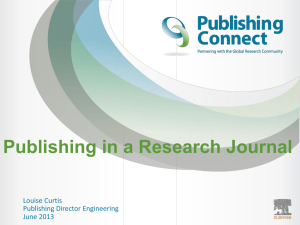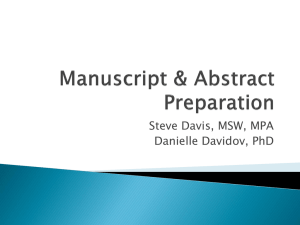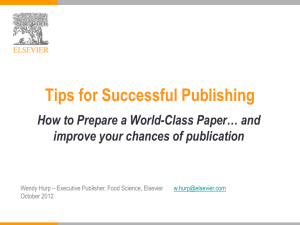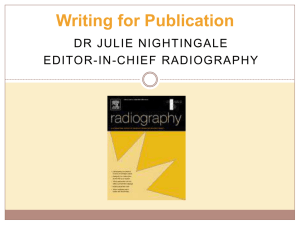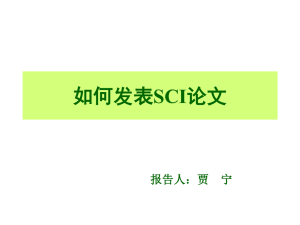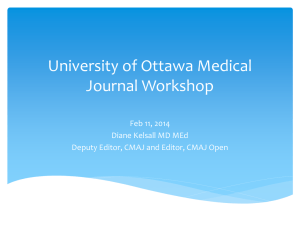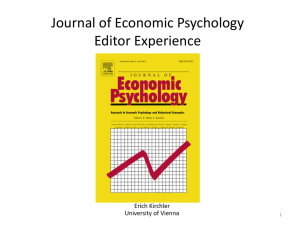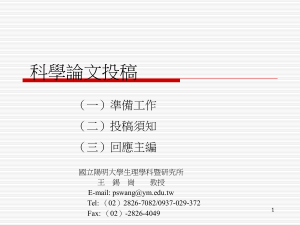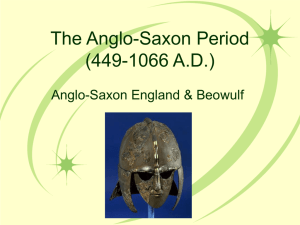internet
advertisement
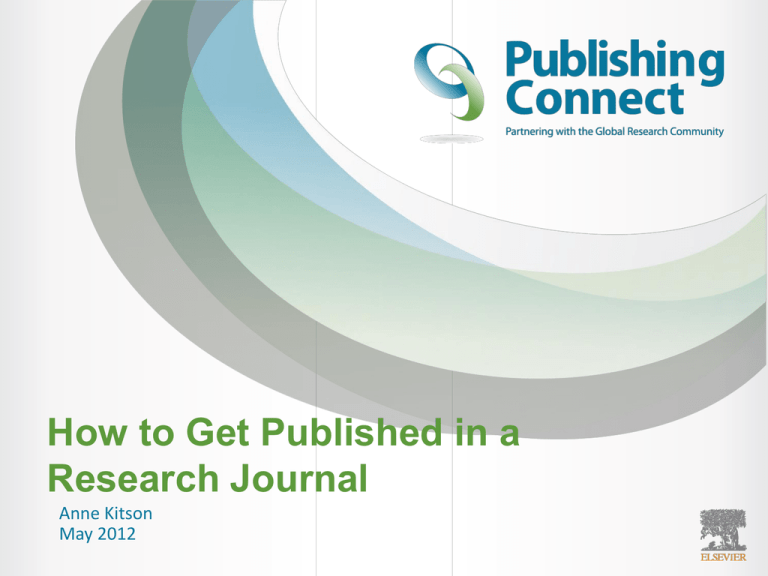
How to Get Published in a Research Journal Anne Kitson May 2012 Thought Question What is it that distinguishes a very good manuscript from a bad one? January 2012 Objectives • What steps do I need to take before I write my paper? • How can I ensure I am using proper manuscript language? • How do I build up my article properly? January 2012 What steps do I need to take before I write my paper? January 2012 Determine if you are ready to publish You should consider publishing if you have information that advances understanding in a specific research field This could be in the form of: • Presenting new, original results or methods • Rationalizing, refining, or reinterpreting published results • Reviewing or summarizing a particular subject or field If you are ready to publish, a strong manuscript is what is needed next January 2012 What is a strong manuscript? • Has a clear, useful, and exciting message • Presented and constructed in a logical manner • Reviewers and editors can grasp the significance easily Editors and reviewers are all busy people – make things easy to save their time January 2012 Decide the most appropriate type of manuscript • • • • Conference Papers Full articles/Original articles Short communications/letters Review papers/perspectives – Self-evaluate your work: Is it sufficient for a full article? Or are your results so thrilling that they need to be shown as soon as possible? – Ask your supervisor and colleagues for advice on manuscript type. Sometimes outsiders see things more clearly than you. January 2012 Conference Papers • Excellent for disseminating early or in-progress research findings • Typically 5-10 pages, 3 figures, 15 references • Draft and submit the paper to conference organisers • Good way to start a scientific research career Sample Conference Paper titles: • • “Global Warming Prevention Technologies in Japan” at 6th Greenhouse Gas Control Technologies International Conference “Power consumption in slurry systems” at 10th European Conference on Mixing January 2012 Full articles/Original article • • • • Standard for disseminating completed research findings Typically 8-10 pages, 5 figures, 25 references Draft and submit the paper to appropriate journal Good way to build a scientific research career Sample full article titles: • • • “Hydrodynamic study of a liquid/solid fluidized bed under transverse electromagnetic field” “Retinoic acid regulation of the Mesp–Ripply feedback loop during vertebrate segmental patterning” “Establishing a reference range for bone turnover markers in young, healthy women” January 2012 Short Communications Articles • Quick and early communications of significant, original advances. • Much shorter than full articles. Sample Short Communications titles: • PLEASE ADD IN SUITABLE EXAMPLES FROM YOUR DISCIPLINE. January 2012 Review papers/perspectives • • • • Critical synthesis of a specific research topic Typically 10+ pages, 5+ figures, 80 references Typically solicited by journal editors Good way to consolidate a scientific research career Sample full article titles: • • • “Advances in the allogeneic transplantation for thalassemia” “Stress and how bacteria cope with death and survival” “Quantifying the transmission potential of pandemic influenza” January 2012 Citations impact varies by publication type January 2012 Choosing the right journal Investigate all candidate journals on Elsevier.com to find out: – Aims and scope – Accepted types of articles – Readership – Current hot topics • go through the abstracts of recent publications January 2012 Choosing the right journal cont.. • Ask for help from your supervisor or colleagues – The supervisor (who is often a co-author) has co-responsibility for your work. • DO NOT gamble by submitting your manuscript to more than one journal at a time. – International ethics standards prohibit multiple/simultaneous submissions, and editors WILL find out! (see also our webcast on publishing ethics www.elsevier.com/editorsupdate). TIP: Articles in your references will likely lead you to the right journal. January 2012 Choosing the right journal cont.. January 2012 Summary – What steps do I need to take before I write my paper? • Determine if you are ready to publish • Decide on the type of manuscript • Choose the target journal • Check the Guide for Authors January 2012 Potential Author Responsibilities • Originality – fabrication, falsification, plagiarism, • Citations and context – crediting and noting permissions • Conflicts of Interest – other activities by the author, EiC at same institute • Authorship – first authors and co-authors; avoid ghost authors, scientific writers, ‘so-called gift authors • Submission – no dual submission • Who else is responsible? All stakeholders have a part to play in • upholding ethics – Authors; institutions/companies/agencies/funding bodies – Publishers/journal editors COPE, PERK tools to assist • Consequences - Written letters of concern and reprimand; article retractions; some form of disciplinary action on the part of the researcher’s institute or funding body 17 Elsevier Author Rights • Publisher agreements do vary, but Elsevier generally allows authors the following uses: – Teaching: allowed to make copies of the article for use in classroom teaching – Educational materials: article can be included in the author’s institution or company e-course packs or company training – Scholarly sharing: copies of the article can be shared w/ research colleagues – Meetings/conferences: Article can be presented and copies can be made for attendees – Further works: article can be used in compilations, expanded to bookform, or used in thesis or dissertation – Patent and trademark rights: for any invention disclosed or product identified 18 Other Allowances & Restrictions • Elsevier’s Posting Allowances – Pre-print version of article to internet websites – Revised personal version of text of final article to author’s personal or institutional website or server – According to funding body agreements (e.g. Wellcome Trust, HHMI, NIH) www.elsevier.com/fundingbodies • Elsevier’s Commercial Purpose Prohibitions – – – – 19 Posting by companies for use by customers Placing advertisements against postings Charging fees for access or document delivery Any form of systematic distribution Elsevier Listens Every journal, platform and product at Elsevier is co-developed with ongoing community input. In 2011 we surveyed or consulted with thousands of individuals: 68,000+ 55,500+ Innovation Explorers: Researchers & Librarians Purchaser/Customer Service Satisfaction 14,000+ 8,000+ Product Feedback Surveys 31,000+ 1,500+ 600+ Librarian Advisory Board 600+ 24 How can I ensure I am using proper Manuscript language? January 2012 Thought Question What are some characteristics of the best manuscript writing you have seen? January 2012 Why is language important? Save your editor and reviewers the trouble of guessing what you mean Complaint from an editor: “[This] paper fell well below my threshold. I refuse to spend time trying to understand what the author is trying to say. Besides, I really want to send a message that they can't submit garbage to us and expect us to fix it. My rule of thumb is that if there are more than 6 grammatical errors in the abstract, then I don't waste my time carefully reading the rest.” January 2012 Do publishers correct language? • No. It is the author’s responsibility to make sure his paper is in its best possible form when submitted for publication • However: – Publishers often provide resources for authors who are less familiar with the conventions of international journals. Please check your publishers’ author website for more information. – Some publishers may perform technical screening prior to peer review. – Visit http://webshop.elsevier.com for translation and language editing services. January 2012 Manuscript Language – Overview Write with clarity, objectivity, accuracy, and brevity • Key to successful manuscript writing is to be alert to common errors: – – – – Sentence construction Incorrect tenses Inaccurate grammar Mixing languages Check the Guide for Authors of the target journal for any language specifications January 2012 Manuscript Language – Sentences An example of what NOT to do: •“If Write direct and administration short sentences it is the case, intravenous should result in that emulsion has higher intravenous administration retention concentration, but which is not in accordance with the result, and therefore the more rational interpretation should SLNidea with mean diameter of of 46nm is greatly different emulsion with •be that One or piece information perfrom sentence is mean diameter of 65 nm in entering tumor, namely, it is probably difficult for sufficient emulsion to enter and exit from tumor blood vessel as freely as SLN, which may be caused by the fact that the tumor blood vessel aperture is smaller.” • Avoid multiple statements in one sentence A possible modification: “It was expected that the intravenous administration via emulsion would have a higher retention concentration. However, the experimental results suggest otherwise. The SLN entered the tumor blood vessel more easily than the emulsion. This may be due to the smaller aperture of the SLN (46 nm) compared with the aperture of the emulsion (65 nm).” January 2012 Manuscript Language – Tenses • Present tense for known facts and hypotheses: “The average life of a honey bee is 6 weeks” • Past tense for experiments you have conducted: “All the honey bees were maintained in an environment with a consistent temperature of 23 degrees centigrade…” • Past tense when you describe the results of an experiment: “The average life span of bees in our contained environment was 8 weeks…” January 2012 Manuscript Language – Grammar • Use active voice to shorten sentences – Passive voice: “It has been found that there had been…” – Active voice: “We found that…” – Passive voice: “carbon dioxide was consumed by the plant…” – Active voice: “…the plant consumed carbon dioxide..” • Avoid abbreviations: “it’s”, “weren’t”, “hasn’t” – Never use them in scientific writing – Only use abbreviations for units of measure or established scientific abbreviations, e.g. DNA January 2012 Manuscript Language – Grammar • Minimize use of adverbs: “However”, “In addition”, “Moreover” • Eliminate redundant phrases “Never say ‘and references therein’ - as in [1] and [25]. Any intelligent •reader Double-check unfamiliar or phrases knows to look at the references in awords paper in order to get even more information.” - Editor “Delete ‘In present report’. It is impossible for it to be in a different report! You start the conclusions "In this report, we have prepared....." This is nonsense. The samples were prepared in the laboratory!” -Editor January 2012 Language Finally, you should use English throughout the manuscript, including figures. January 2012 Summary – How can I ensure I am using proper manuscript language? • Proper manuscript language is important so that editors and reviewers can easily understand your messages • Refer to the journal’s Guide for Authors for specifications • Check that your paper has short sentences, correct tenses, correct grammar, and is all in English • Have a native English speaker check your manuscript or use a language editing service January 2012 How do I build up my article properly? January 2012 Read the ‘Guide for Authors’! • You can find the Guide for Authors on the journal homepage on Elsevier.com • Stick to the Guide for Authors in your manuscript, even in the first draft (text layout, nomenclature, figures & tables, references etc.). In the end it will save you time, and also the editor’s. • Editors (and reviewers) do not like wasting time on poorly prepared manuscripts. January 2012 General structure of a research article • Title • Abstract • Keywords The Make them easy for progression of the thematic indexing and searching! (informative, attractive, scope of a paper: effective) general specific general • Main text (IMRAD) Journal space is not However, we often write in the – Introduction unlimited. – Methods following order: Make your article as – Results as possible. – Figuresconcise and tables – And – Discussions– Methods, Results and Discussion • Conclusions – Conclusions and Introduction • Acknowledgements – Abstract and title • References • Supplementary Data January 2012 Title • A good title should contain the fewest possible words that adequately describe the content of a paper. • Effective titles – – – – Identify the main issue of the paper Begin with the subject of the paper Are accurate, unambiguous, specific, and complete Are as short as possible • Articles with short, catchy titles are often better cited • Do not contain rarely-used abbreviations January 2012 Title Original Title Revised Remarks Preliminary observations on the effect of Zn element on anticorrosion of zinc plating layer Effect of Zn on anticorrosion of zinc plating layer Long title distracts readers. Remove all redundancies such as “observations on”, “the nature of”, etc. Action of antibiotics on bacteria Inhibition of growth of mycobacterium tuberculosis by streptomycin Titles should be specific. Think to yourself: “How will I search for this piece of information?” when you design the title. Fabrication of carbon/CdS coaxial nanofibers displaying optical and electrical properties via electrospinning carbon Electrospinning of carbon/CdS coaxial nanofibers with optical and electrical properties “English needs help. The title is nonsense. All materials have properties of all varieties. You could examine my hair for its electrical and optical properties! You MUST be specific. I haven’t read the paper but I suspect there is something special about these properties, otherwise why would you be reporting them?” – the Editor-in-chief January 2012 Abstract … is freely available in electronic abstracting & indexing services [PubMed, Medline, Embase, SciVerse Scopus, ....] – This is the advertisement of your article. We tackle the general linear instantaneous modeland (possibly Make it interesting, easy to be understood underdetermined and noisy) where we model the source prior with a Student t distribution. The conjugate-exponential characterisation of the t without reading the whole article. distribution as an infinite mixture of scaled Gaussians enables us to do What has efficient inference. We study two well-known inference methods, Gibbs – You must accurate and We specific! sampler and variational Bayes be for Bayesian source separation. derive been done both techniques as local message passing algorithms to highlight their algorithmic similarities andabstract to contrast theirwill different convergence influence whether – A clear strongly characteristics and computational requirements. Our simulation results suggest that typical posterior distributions in source or not your work is further considered. separation have multiple local maxima. Therefore we propose a hybrid What are the approach where we explore the state space with a Gibbs sampler and – toKeep it asalgorithm. briefThisasapproach possible!!! main findings then switch a deterministic seems to be able to combine the speed of the variational approach with the robustness of the Gibbs sampler. January 2012 Keywords Used by indexing and abstracting services • They are the labels of your manuscript. • Use only established abbreviations (e.g. DNA) • Check the ‘Guide for Authors’ Article Title Keywords “Silo music and silo quake: granular flow-induced vibration” Silo music, Silo quake, stick-slip flow, resonance, creep, granular discharge “An experimental study on evacuated tube solar collector using supercritical CO2” Solar collector; Supercritical CO2; Solar energy; Solar thermal utilization 38 January 2012 Introduction Provide context to convince readers that you clearly know why your work is useful Sample 1st paragraph of an Introduction • Be brief • Clearly address the following: – What is the problem? – Are there any existing solutions? – Which solution is the best? – What is its main limitation? – What do you hope to achieve? • Try to be consistent with the nature of the journal Zhang, XR; Yamaguchi, H. “An experimental study on evacuated tube solar collector using supercritical CO2” Applied Thermal Engineering © Elsevier 39 January 2012 Methods st paragraph of an Experimental Set-Up section Sample 1Describe how the problem was studied • Include detailed information • Do not describe previously published procedures • Identify the equipment and describe materials used Zhang, XR; Yamaguchi, H. “An experimental study on evacuated tube solar collector using supercritical CO2” Applied Thermal Engineering © Elsevier 40 January 2012 Ethics Committee approval • Experiments on humans or animals must follow applicable ethics standards – e.g. most recent version of the Helsinki Declaration and/or relevant (local, national, international) animal experimentation guidelines • Approval of the local ethics committee is required, and should be specified in the manuscript • Editors can make their own decisions as to whether the experiments were done in an ethically acceptable manner – Sometimes local ethics approvals are below internationally accepted standards January 2012 Results – what have you found? • Tell a clear and easy-to-understand story. RED THREAD – Be structured (sub-headings) • The following should be included: – The main findings • Thus not all findings (Add Supplementary Materials for data of secondary importance) • Findings from experiments described in the Methods section – Highlight findings that differ from findings in previous publications, and unexpected findings – Results of the statistical analysis January 2012 Results – Figures and tables • Illustrations are critical, because • Figures and tables are the most efficient way to present results and; • Results are the driving force of the publication • Captions and legends must be detailed enough to make figures and tables selfexplanatory • No duplication of results described in text or other illustrations January 2012 "One Picture is Worth a Thousand Words" Sue Hanauer (1968) Discussion Sample 1st paragraph of an Discussion section What the results mean • Most important section • Make the Discussion correspond to the Results • You need to compare published results with yours 44 January 2012 Muite, B.K., Quinn, S.F., Sundaresan, S., Rao, K.K.. “Silo music and silo quake: granular flow-induced vibration” Powder Technology. © Elsevier Conclusion How the work advances the field from the present state of knowledge Sample Conclusion • Should be clear • Justify your work in the research field • Suggest future experiments Muite, B.K., Quinn, S.F., Sundaresan, S., Rao, K.K.. “Silo music and silo quake: granular flow-induced vibration” Powder Technology. © Elsevier 45 January 2012 References Cite the main scientific publications on which your work is based • Do not use too many references • Always ensure you have fully absorbed material you are referencing and do not just rely on checking excerpts or isolated sentences • Avoid excessive self-citations • Avoid excessive citations of publications from the same region • Conform strictly to the style given in the Guide for Authors Muite, B.K., Quinn, S.F., Sundaresan, S., Rao, K.K.. “Silo music and silo quake: granular flow-induced vibration” Powder Technology. © Elsevier 46 January 2012 Acknowledgments Ensures those who helped in the research are recognised Include individuals who have assisted with your study, including: • Advisors • Financial supporters • Proofreaders • Typists • Suppliers who may have given materials 47 January 2012 Summary – How do I build up my article properly? • • • • • • • • 48 Title Abstract Keywords Main text (IMRAD) – Introduction – Methods – Results – And – Discussions Conclusion Acknowledgement References Supporting Materials January 2012 • Structure your article properly • Make sure each section of the paper fulfills its purpose clearly and concisely Cover Letter Your chance to speak to the editor directly Final approval from all authors • Submitted along with your manuscript • Mention what would make your manuscript special to the journal • Note special requirements of interest) Suggested reviewers 49 January 2012 Explanation of importance of research (reviewers, conflicts Authorship General principles for who is listed first • First Author • Conducts and/or supervises the data generation and analysis and the proper presentation and interpretation of the results • Puts paper together and submits the paper to journal • Corresponding author • The first author or a senior author from the institution Avoid • Ghost Authorship – leaving out authors who should be included • Gift Authorship – including authors who did not contribute significantly • Spelling names: Be consistent! January 2012 Revision Revise before submission • Vet the manuscript as thoroughly as possible before submission • Ask colleagues and supervisors to review your manuscript Finally, SUBMIT your manuscript with a cover letter and await a response… 51 January 2012 After submission • Refereeing speed varies tremendously between journals • The Editor will decide to “Accept”, “Accept with Revision (Minor or Major)”, or “Reject” the manuscript 52 January 2012 Thank you For writing/submission tips and author services: www.elsevier.com/authors For online trainings and tutorials: http://trainingdesk.elsevier.com For reviewer information and guidelines: www.elsevier.com/reviewers
